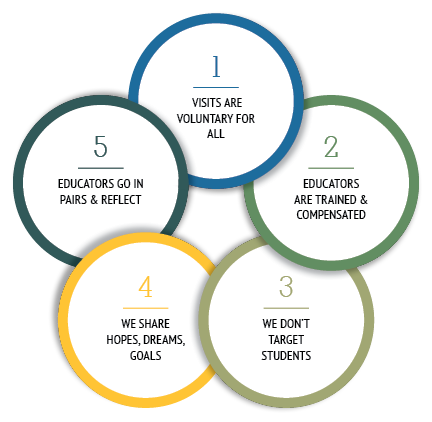Five Strategies for Family Engagement in Schools

Is Your School District Listening?
Community engagement has been mandated in California for five years as a part of Local Control and Accountability Plans (LCAPs), yet parents and students still feel that their voices aren’t heard.
 Jonathan Raymond
Jonathan RaymondPersonally, I’m not surprised. As I learned during my tenure as school superintendent in Sacramento, authentic engagement with the community takes trust, transparency, and equitable outreach. In other words, everything that’s required is what most bureaucracies are too clumsy, risk-averse, and top-down to do well.
The good news is that California is on a path to help local community members play an active role in school district decision-making, including a plan to invest over $13 million in the next six years. Having personally experienced the good, the bad, and the ugly when it comes to engaging communities and families around public education, here are my top 5 strategies for success. Feel free to share these ideas with decision makers in your school district. What they do is essential in making family and community engagement successful.
1. Explain the Why
"Build relationships, and they'll give it all they've got."
Most school districts — like most organizations — operate as hierarchies. Orders come from the top, and the expectation is for those orders to be followed without question. One problem with that model is absence of buy-in: The people lower down the ladder — like principals — may do what they’re told, but their enthusiasm is likely to be nil. As Superintendent, I learned quickly that real leadership requires trust and collaboration: If you want to maximize your outcome, then instead of issuing an order, explain the why and ask for feedback.
In the case of community engagement, it’s one thing to instruct teachers and principals to engage with parents — and entirely something else to share the facts about parental involvement in schools.
It's proven: Students whose parents take an active interest in their children’s education get better grades, have better social skills, and are more likely to graduate from high school and go to college. Until they understand the why, educators may operate with the same assumptions and biases as the rest of the world. Yet the data are clear: Economically disadvantaged parents have the same degree of interest and involvement in their children’s education as their wealthier peers.
When your front-line ambassadors—your teachers, principals, and school staff—understand that forging better relationships with families yields better outcomes for children across the economic spectrum, they will value their own role in the process, and give it all they’ve got.
2. Engage with Equity
Equity is not Equal
People sometimes confuse equity with equal treatment. Equal treatment means treating everyone the same way: "We sent out a flyer inviting all parents to the school board meeting, but only 4 people showed up."
Equity is different. It starts by asking questions:
- What languages do families speak at home? Was the flyer translated?
- How many children have parents who can’t read?
- Was the PTA meeting scheduled during work hours?
- Will parents who fled dictatorships feel intimidated meeting with the school board?
- Did the photo in the flyer include families of all races?
- Are we welcoming to single mothers, grandparents, LGBT families, and other nontraditional families?
In any school district, families come from different walks in life. Bringing all of them into the process will require different types and levels of effort, and that’s OK. In fact, it’s more than OK. It’s a lesson in equity, and the payoff will be amazing. We all have so much to learn from one another, if we take the time to reach out, truly listen, and ensure that all of us are heard.
3. Go Home
Let educators reach them where they are
As former Sacramento Teacher of the Year Stephanie Smith observed:
"We ask [parents] to come to back-to-school nights and teacher conferences without having tried to understand their reality. What if we, educators, took the first step? It’s time for school districts to rethink the approach of inviting parents into a prescribed time period and place and instead reach families and parents where they are.”
What Smith proposes is a step toward equity, and I saw its impact first-hand in Sacramento, where the Parent Teacher Home Visit Project (PTHVP) trained our teachers to engage families in education through visiting their homes.
What are your hopes and dreams for your child? That was the question at the heart of every visit. PTHVP, which improves attendance and test scores and reduces disciplinary actions, works because it nurtures trust, a rare commodity between people and state institutions.

Aimed at family empowerment, home visits are an appointment between two willing participants — parent and teacher — not a “home invasion” like other more punitive types of visits from social workers or state officials. At its heart, educating and developing children is about relationships — among students, educators, families, and community.
4. Educate Everyone
Open the Schools!
In Sacramento, my team worked hard to make our district schools into community centers serving everyone. If your goal is community engagement with schools, then open the schools to the community!
- Remove the fences and open green space up to neighborhoods often defined by fenced-in lots with barking dogs.
- Provide community access to school libraries and computer labs.
- Open a health and welfare center for students and their families.
- Give parents a resource room in each school so they have a space to call their own.
- And, like we did, fight to preserve adult education programs in the face of the inevitable budget cuts. The value of adult education is exponential.
Many adult students are immigrants seeking English literacy and language skills to better provide for their families. But besides yielding greater earnings for parents, improved adult literacy directly impacts children: According to the National Institutes of Health, maternal literacy outweighs income and neighborhood in shaping a child’s chances of succeeding in school. Job skills and education also correlate to better health in adults and their children. When people argue that we can’t afford to provide adult education to immigrants and other disadvantaged adults, my answer is: we can’t afford not to. Improved community engagement is just one positive outcome among many.
5. Prioritize Transparency
School budget information is often indecipherable. In my experience, it’s not just indecipherable to parents. Sometimes it feels like the people crafting the budget are counting on the fact that none of the stakeholders — teachers, administrators, parents, or legislators — can fully understand where all the money is going.
Show the whole picture.
But transparency means more than openness about numbers. To me, it also means being frank and honest when hard decisions need to be made. Some districts complain that parents don’t see the whole picture and expect their priorities to pass despite scant resources and competing concerns. My answer is: Show them the whole picture.
Don’t confuse community engagement with PR. Instead of painting a rosy image when your district is in trouble, let the people know. When Sacramento schools desperately needed a bond measure to pass, our parents, teachers, and administrators worked shoulder-to-shoulder to muster the votes because everyone knew how urgently we needed the funds.
Does transparency work? I’ll leave you with this brief story. In my district, we initiated community budget forums, and the staff member who operated our portable sound system traveled around with me to all of them. After the last one, he approached me. “Superintendent,” he said, “I know I might lose my job given how dire our situation is, but thank you for helping me finally understand why, and what’s at stake for our children.”
These five approaches to engage and empower parents, families, and community don’t come without effort and focus, yet school districts don’t need to reinvent the wheel to do this work well. Lots of models exist. What’s required is a vision; remembering that parents and families are a district’s most important partners; getting out into the community to engage people on their terms; and bringing a sense of humility to the work.
 Jonathan Raymond served as superintendent of the Sacramento City Unified School District from 2009 to 2013. He is now president of the Stuart Foundation, a California–based private foundation. Its guiding principle is an education system that values the Whole Child by strengthening the relationships among students, educators, families, and communities.
Jonathan Raymond served as superintendent of the Sacramento City Unified School District from 2009 to 2013. He is now president of the Stuart Foundation, a California–based private foundation. Its guiding principle is an education system that values the Whole Child by strengthening the relationships among students, educators, families, and communities.For more about Jonathan's ideas, see his posts on Medium and hear his interview with John Fensterwald for the EdSource podcast.
Ed100.org is proud to be a grant recipient of the Stuart Foundation.
Tags on this post
All Tags
A-G requirements Absences Accountability Accreditation Achievement gap Administrators After school Algebra API Arts Assessment At-risk students Attendance Beacon links Bilingual education Bonds Brain Brown Act Budgets Bullying Burbank Business Career Carol Dweck Categorical funds Catholic schools Certification CHAMP Change Character Education Chart Charter schools Civics Class size CMOs Collective bargaining College Common core Community schools Contest Continuous Improvement Cost of education Counselors Creativity Crossword CSBA CTA Dashboard Data Dialogue District boundaries Districts Diversity Drawing DREAM Act Dyslexia EACH Early childhood Economic growth EdPrezi EdSource EdTech Education foundations Effort Election English learners Equity ESSA Ethnic studies Ethnic studies Evaluation rubric Expanded Learning Facilities Fake News Federal Federal policy Funding Gifted Graduation rates Grit Health Help Wanted History Home schools Homeless students Homework Hours of opportunity Humanities Independence Day Indignation Infrastructure Initiatives International Jargon Khan Academy Kindergarten LCAP LCFF Leaderboard Leadership Learning Litigation Lobbyists Local control Local funding Local governance Lottery Magnet schools Map Math Media Mental Health Mindfulness Mindset Myth Myths NAEP National comparisons NCLB Nutrition Pandemic Parcel taxes Parent Engagement Parent Leader Guide Parents peanut butter Pedagogy Pensions personalized Philanthropy PISA Planning Policy Politics population Poverty Preschool Prezi Private schools Prize Project-based learning Prop 13 Prop 98 Property taxes PTA Purpose of education puzzle Quality Race Rating Schools Reading Recruiting teachers Reform Religious education Religious schools Research Retaining teachers Rigor School board School choice School Climate School Closures Science Serrano vs Priest Sex Ed Site Map Sleep Social-emotional learning Song Special ed Spending SPSA Standards Strike STRS Student motivation Student voice Success Suicide Summer Superintendent Suspensions Talent Teacher pay Teacher shortage Teachers Technology Technology in education Template Test scores Tests Time in school Time on task Trump Undocumented Unions Universal education Vaccination Values Vaping Video Volunteering Volunteers Vote Vouchers Winners Year in ReviewSharing is caring!
Password Reset
Search all lesson and blog content here.
Login with Email
We will send your Login Link to your email
address. Click on the link and you will be
logged into Ed100. No more passwords to
remember!














Questions & Comments
To comment or reply, please sign in .